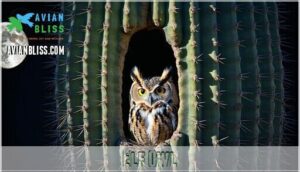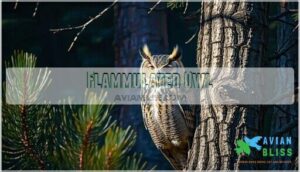This site is supported by our readers. We may earn a commission, at no cost to you, if you purchase through links.
 You’ll discover nine distinct arizona owl sounds echoing across the desert after dark.
You’ll discover nine distinct arizona owl sounds echoing across the desert after dark.
Great Horned Owls produce deep "who-who-who" hoots that carry for miles, while Barn Owls create spine-chilling shrieks that sound like movie monsters.
Western Screech-Owls make bouncing ball trills, and tiny Elf Owls chirp like puppies from saguaro cacti.
Burrowing Owls chatter from underground burrows, Short-eared Owls bark during flight, and Long-eared Owls hoot softly in dense cover.
Northern Saw-whet Owls produce repetitive toots, while Flammulated Owls make low hoots that sound oddly musical.
Each species uses these unique vocalizations to communicate territory boundaries and attract mates.
Learning these calls transforms your nighttime desert adventures into fascinating wildlife detective work.
It allows you to explore the desert with a new perspective, understanding the unique vocalizations of each species and how they interact with their environment.
Table Of Contents
- Key Takeaways
- What Sounds Do Arizona Owls Make?
- Great Horned Owl
- Barn Owl
- Long-eared Owl
- Burrowing Owl
- Short-eared Owl
- Western Screech-Owl
- Northern Saw-whet Owl
- Elf Owl
- Flammulated Owl
- Frequently Asked Questions (FAQs)
- What is the most common owl in Arizona?
- What does it mean when an owl is hooting outside your house?
- What kind of owls hoot at night?
- When are Arizona owls most vocal during night?
- How far can Arizona owl calls travel?
- Do Arizona owls call during breeding season only?
- Which Arizona owl species sounds most like screaming?
- Can Arizona owls recognize individual human voices?
- Conclusion
Key Takeaways
- You’ll identify nine distinct Arizona owl species by their unique vocalizations – from Great Horned Owls‘ deep "who-who-who" hoots to Barn Owls’ spine-chilling shrieks and Elf Owls’ puppy-like chirps from saguaro cacti.
- You can distinguish owl calls by listening for specific patterns: pitch, rhythm, and repetition – with Great Horned Owls producing low-frequency hoots while Elf Owls create high-pitched yipping sounds that carry surprisingly far through desert air.
- You’ll hear Arizona owls most actively during dawn and dusk hours, particularly between 10 PM and 2 AM when they’re hunting, with calls intensifying during breeding season from winter through spring.
- You can transform your nighttime desert adventures into wildlife detective work by learning these calls – each species uses vocalizations to establish territory boundaries, attract mates, and communicate with family members across Arizona’s diverse landscapes.
What Sounds Do Arizona Owls Make?
Across Arizona’s desert landscapes and mountain forests, nine distinct owl species create a nighttime symphony that’s both haunting and beautiful.
You’ll discover that arizona owl sounds range from deep, resonating hoots to sharp, piercing screeches, each serving specific purposes in owl communication.
Arizona’s desert nights come alive with haunting hoots, ghostly screeches, and mysterious calls that echo through moonlit canyons.
These vocalizations aren’t random noise—they’re sophisticated acoustic signals with distinct sound frequency patterns. Each species has developed unique call variations that help establish territory, attract mates, and communicate with family members.
Through acoustic analysis, researchers have identified regional dialects among owl populations, with subtle differences between northern and southern Arizona calls.
When identifying owl sounds, listen for pitch, rhythm, and repetition patterns. Great Horned Owls produce low-frequency hoots, while Elf Owls create high-pitched yipping sounds. Barn Owls screech rather than hoot, and Burrowing Owls make distinctive "coo-coo" calls.
The burrowing owl nests on the ground, often in prairie dog towns.
Understanding owl vocalizations arizona helps you connect with these mysterious nocturnal hunters and appreciate the complex communication systems that govern their hidden world.
Great Horned Owl
Arizona’s most formidable owl, the Great Horned Owl (Bubo virginianus), delivers the desert’s most iconic nighttime soundtrack.
The Great Horned Owl’s haunting "hoo-h’HOO-hoo-hoo" echoes through Arizona’s canyons like nature’s own desert symphony.
You’ll recognize their deep, stuttering "hoo-h’HOO-hoo-hoo" calls echoing across canyons and forests from dusk until dawn. These powerful owl vocalizations serve as territorial markers and mating calls, with females hooting first at a higher pitch, followed by males responding lower.
Their impressive physical traits include:
- Wingspan reaching 4 feet – making them Arizona’s largest breeding owl species
- Distinctive ear tufts resembling horns that give them their name
- Bright yellow eyes perfectly adapted for nocturnal hunting
- Silent flight feathers allowing stealthy approaches to prey
These owls often use abandoned nests of other large birds. Great horned owl calls also include shrieks, screams, and bill snapping during territorial disputes.
Their diverse hunting strategy targets mammals, birds, and reptiles. These arizona owl species nest in saguaro cavities or abandoned hawk nests, adapting well despite habitat pressures affecting their conservation status.
Barn Owl
That ghostly white silhouette gliding silently through Arizona’s darkness belongs to the Barn Owl, a nocturnal hunter with a distinctive heart-shaped face.
You’ll recognize this desert adaptation specialist by its bone-chilling shrieks and hissing calls that echo across open grasslands. These monogamous birds screech rather than hoot, producing some of Arizona’s most spine-tingling owl sounds.
Listen for their raspy vocalizations while they hunt field mice with exceptional hearing. Their eerie owl vocalizations make them unforgettable among Arizona owl sounds you’ll encounter after sunset.
They play a crucial role in controlling rodent populations.
Long-eared Owl
Few arizona owl sounds are as mysteriously beautiful as the Long-eared Owl‘s deep, resonant hoots echoing through the night. This medium-sized owl masters camouflage techniques with its streaky brown plumage that blends seamlessly into tree bark.
You’ll rarely spot one during daylight due to their elusive behavior and expert roosting habits in dense woodland cover. Long-eared owls hunt with remarkable precision, floating silently over grasslands and marshes.
Their diet analysis reveals a preference for voles, mice, and small mammals, which they capture using exceptional hearing abilities. Those distinctive feather tufts aren’t actually ears—they’re camouflage tools that help break up their outline. Like the boreal owl’s habitat, they favor dense woods.
Listen for their low, breathy hoots carrying up to half a mile on still nights. These arizona bird sounds are often described as someone blowing across a large bottle opening.
- Best listening times: Dawn and dusk when they’re most vocal
- Habitat clues: Dense woods bordering open fields and grasslands
- Call pattern: 10-200 evenly spaced "whoo" sounds in sequence
Burrowing Owl
Unlike the secretive Long-eared Owl, you’ll spot Burrowing Owls during broad daylight hours thanks to their diurnal hunting habits.
These ground dwelling birds stand out with their vivid yellow eyes and remarkably long legs, perfectly adapted for arizona owl habitat in desert grasslands.
Their distinctive "coo-coo" calls echo across open terrain as they defend underground territories. You’ll often find these arizona birding owls perched near burrow entrances, scanning for insects and small rodents.
What makes them truly unique? Their quirky behavior of collecting shiny hoards like bottle caps and coins to decorate their homes. They often repurpose existing burrows for nesting.
| Behavior | Description |
|---|---|
| Dung Use | Carpet burrow entrances with animal dung |
| Burrow Acquisition | Dig own tunnels or occupy abandoned prairie dog holes |
| Arizona Bird Sounds | High-pitched "coo-coos" and chattering calls |
| Arizona Owl Sightings | Active day and night in grassland areas |
These burrowing owl sounds make them Arizona’s most vocal daytime owl species.
Short-eared Owl
You’ll spot this medium-sized raptor swooping low across Arizona’s grasslands during winter migration, when Short-Eared Owls arrive from northern breeding grounds.
Unlike most owls, these hunters show remarkable diurnal activity, often appearing at dawn and dusk with their distinctive moth-like flight patterns.
Their arizona owl sounds differ dramatically from other species. Outside breeding season, they’re mostly silent, but when they do vocalize, you’ll hear soft, low-pitched calls and distinctive wing claps.
These arizona wildlife sounds peak between late March and early June during territorial displays. The owls thrive in open grassland habitats.
Here’s what makes their hunting extraordinary:
- Silent death from above – specialized feather edges eliminate flight noise
- Ground-scanning precision – they fly just feet above grass listening for voles
- Acoustic mastery – their facial disk funnels the tiniest prey sounds to razor-sharp hearing
Their habitat preference for open meadows and wetlands reflects perfect adaptation to grassland ecosystems. While their conservation status remains stable, these arizona bird calls represent nature’s acoustic engineering at its finest.
Western Screech-Owl
You’ll hear soft whistles and gentle trills rather than actual screeches from these compact Urban Owls.
Western Screech Owl calls echo through Arizona neighborhoods after sunset, with males producing distinctive "hoo-hoo" sounds for territorial communication.
These owl calls arizona residents recognize measure 8-10 inches long with feathered ear tufts that aren’t actually ears.
Their Habitat Adaptations allow them to thrive from desert cacti to city parks.
Diet Specifics include worms, rats, and bats hunted silently at night.
Identification Tips focus on their mottled gray-brown plumage that camouflages perfectly against tree bark.
Breeding Habits involve nesting in woodpecker holes and tree cavities, making them one of arizona owl types perfectly suited for suburban life.
Their diet reflects their adaptability, with prey variations seasonally impacting their foraging habits.
Northern Saw-whet Owl
The Northern Sawwhet Owl produces one of the most distinctive owl vocalizations arizona residents can hear – a repetitive "too-too-too" call that sounds like someone sharpening a saw on a whetstone.
These owl calls arizona nights feature carry up to 1,000 feet through dense forest air, making call frequency incredibly useful for locating these secretive birds.
Despite measuring only 8 inches long, this smallest member of arizona owl types packs serious hunting power.
Their prey selection focuses primarily on deer mice, voles, and shrews, which they catch during silent nighttime flights through coniferous forests.
Saw-whet habitat includes dense pine and fir stands where they roost during daylight hours.
Their nesting habits involve using abandoned woodpecker holes or artificial boxes placed 12-20 feet high.
These owl sounds intensify during breeding season as males establish territory.
Like the boreal owl’s habitat, they also prefer dense coniferous forests.
Migration patterns bring northern populations south during harsh winters, making late fall and early spring prime listening times for these remarkable raptors.
Elf Owl
Arizona’s tiniest owl packs a surprising vocal punch despite weighing less than two ounces.
The Elf Owl stands as the world’s smallest owl species, measuring just 5-6 inches tall with a wingspan barely reaching 10 inches.
You’ll hear their distinctive yipping calls echoing through desert nights, particularly during breeding season when these arizona nocturnal birds become most vocal.
These remarkable hunters have mastered desert survival through their specialized insect diet and unique nesting habits:
- Cactus nests carved into saguaro cavities provide perfect protection from predators
- Tiny size allows them to hunt insects near streetlights and porch lights
- Yipping calls create territorial boundaries across their desert territories
- Migratory range extends from Mexico to Arizona’s Sonoran Desert regions
The elf owl call resembles a puppy’s bark more than traditional owl vocalizations arizona residents expect.
These owl sounds carry surprisingly far through still desert air, helping you locate these elusive hunters during their nocturnal activities.
They’re known to have softened feathers for silent flight.
Flammulated Owl
Moving from the desert-dwelling Elf Owl, you’ll encounter the Flammulated Owl in Arizona’s mountain forests during summer months.
This small migrant produces soft, low-pitched hoots that echo through pine canyons after dark.
Unlike other arizona owl sounds, its vocalizations are surprisingly deep for such a tiny bird.
Their breeding range spans western North America.
| Characteristic | Details |
|---|---|
| Migration Patterns | Arrives May, departs September |
| Habitat Preferences | Ponderosa pine, mixed conifer forests |
| Diet Analysis | Moths, beetles, flying insects |
| Conservation Status | Stable but habitat-dependent |
You’ll need sharp ears to detect this owl call, as it blends seamlessly with nighttime forest sounds.
For owl identification arizona enthusiasts, the Flammulated Owl represents one of the most challenging arizona nocturnal birds to locate.
Its camouflaged plumage and secretive nature make visual confirmation difficult, but those haunting vocalizations reveal its presence in suitable mountain habitat.
Frequently Asked Questions (FAQs)
What is the most common owl in Arizona?
You’ll find the Great Horned Owl everywhere across Arizona, from desert floors to mountain forests.
With its distinctive ear tufts and piercing yellow eyes, it’s the state’s most widespread and commonly encountered owl species.
What does it mean when an owl is hooting outside your house?
Like nature’s neighborhood watch, that hooting owl outside your house is simply claiming territory, calling for a mate, or communicating with family members.
You’re hearing their natural nighttime conversation—nothing mysterious or ominous about it, it’s just their way of communicating.
What kind of owls hoot at night?
Several owl species hoot at night, including Great Horned Owls with deep "hoo-hoo-hoo" calls.
Barn Owls that screech rather than hoot, and Long-eared Owls producing low, haunting hoots during their nocturnal hunting activities.
When are Arizona owls most vocal during night?
Darkness becomes nature’s stage when Arizona owls release their symphony. You’ll hear them most actively during dawn and dusk hours, particularly between 10 PM and 2 AM when they’re hunting prey.
How far can Arizona owl calls travel?
You’ll hear Northern Saw-whet Owl calls travel up to 1,000 feet through Arizona’s quiet desert air.
Other species’ calls carry shorter distances, typically 200-500 feet, depending on terrain, weather conditions, and surrounding vegetation density.
Do Arizona owls call during breeding season only?
Arizona owls don’t restrict their calling to breeding season alone.
You’ll hear them year-round for territory defense, hunting coordination, and communication.
However, their calls become more frequent and intense during mating periods from winter through spring.
Which Arizona owl species sounds most like screaming?
Barn owls produce the most scream-like sounds you’ll hear in Arizona.
Unlike other species that hoot, they emit harsh screeches and shrieks that can sound genuinely terrifying, especially during nighttime encounters, which makes their scream-like sounds even more noticeable.
Can Arizona owls recognize individual human voices?
Wise winged creatures can’t recognize your specific voice like pets do.
They respond to general human sounds and movement patterns, but they don’t distinguish between individual people’s voices or vocal characteristics, which makes them nocturnal hunters.
Conclusion
Mastering arizona owl sounds transforms your desert nights into a symphony of discovery.
You’ll recognize the Great Horned Owl’s territorial hoots, the Barn Owl’s haunting shrieks, and the Elf Owl’s puppy-like chirps with practice.
Each species reveals its presence through distinct calls that echo across Arizona’s landscapes.
Grab your flashlight, download owl apps for reference, and venture into the desert darkness.
You’re now equipped to identify these nine remarkable species and discover the secrets of Arizona’s nocturnal hunters.
- https://globalbirdinginitiative.org/bird-identification/species-by-location/arizona-us/arizona-owl-sounds/
- https://avianbirds.com/owls-in-arizona/
- https://www.owlsenserecorders.com/audio-analysis
- https://animalvivid.com/owls-in-arizona/
- https://www.pacificmegascops.org/blog/owls-in-arizona-delving-into-screech-owl-microclimates










